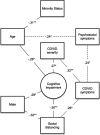Cognitive Impairment in Non-critical, Mild-to-Moderate COVID-19 Survivors
- PMID: 35250714
- PMCID: PMC8891805
- DOI: 10.3389/fpsyg.2022.770459
Cognitive Impairment in Non-critical, Mild-to-Moderate COVID-19 Survivors
Abstract
Importance: Previous studies of post-acute COVID-19 syndrome have focused on critical cases with severe disease. However, most cases are mild to moderate in disease severity.
Objective: We aimed to examine cognitive outcomes in cases of non-critical, mild-to-moderate COVID-19. Design, Setting, and Participants: In this cross-sectional study, we enrolled 72 adults aged 22 to 65 years in Central Texas who had non-critical, mild-to-moderate COVID-19 infection between 13 January 2021 and 20 April 2021.
Main outcomes and measures: We remotely administered cognitive-behavioral testing to determine the frequency of cognitive impairment and examine demographic, clinical, and psychosocial contributors to impairment.
Results: The frequency of objective cognitive impairment was 40%. The largest number of participants (24%) showed impairment on a measure of executive functioning. Attention and processing speed was more impaired in males (OR = 1.5, 95%CI = 0.23-2.9). Males endorsed lower adherence to social distancing guidelines (U = 590, p = 0.01), which was in turn associated with cognitive impairment across participants (r = -0.30, p = 0.01). Younger age was correlated with impairment (r = -0.26, p = 0.03) but was also associated with racial/ethnic minority status (r = -0.31, p = 0.01) and increased psychological symptoms (p < 0.04). Greater number of COVID-19 symptoms was correlated with lower subjective cognitive function (r = -0.38, p = 0.001) as well as psychosocial function (r > 0.24, p < 0.05). Moderate COVID-19 severity was associated with attention/processing speed impairment (r = 0.27, p = 0.03), increased pain (r = 0.31, p = 0.01), and higher number of COVID-19 symptoms (r = 0.32, p = 0.01).
Conclusion and relevance: Mild or moderate COVID-19 infection may be associated with cognitive impairments, especially in the domain of executive functioning. A subgroup of younger individuals may be more vulnerable to cognitive and psychosocial effects of COVID-19.
Highlights: Question: How frequent is cognitive impairment among non-critical, mild-to-moderate COVID-19 survivors?
Findings: In this cross-sectional study of 72 adults, 40% demonstrated cognitive impairment, particularly in executive function.
Meaning: Neurologic sequelae, such as cognitive impairment, may be common following COVID-19 infection.
Keywords: COVID-19; anxiety; cognition; executive function; psychosocial.
Copyright © 2022 Henneghan, Lewis, Gill and Kesler.
Conflict of interest statement
The authors declare that the research was conducted in the absence of any commercial or financial relationships that could be construed as a potential conflict of interest.
Figures

References
-
- Atchison C. J., Bowman L., Vrinten C., Redd R., Pristerà P., Eaton J. W., et al. (2020). Perceptions and behavioural responses of the general public during the COVID-19 pandemic: A cross-sectional survey of UK adults. medRxiv. doi: 10.1101/2020.04.01.20050039 [Epub Ahead of Print] - DOI - PMC - PubMed
Grants and funding
LinkOut - more resources
Full Text Sources
Miscellaneous

